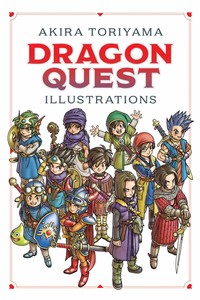Review
by Rebecca Silverman,Dragon Quest Illustrations: 30th Anniversary Edition
Artbook
| Synopsis: |  |
||
Akira Toriyama and other members of the Dragon Quest team reflect back on thirty years of game art with limited commentary. |
|||
| Review: | |||
It's hard to find someone who has never heard of Akira Toriyama, or at least his works. After his arrival on the shounen manga scene with Dr. Slump, Toriyama solidified his fame with the extensive Dragon Ball series, spin-offs of which continue to be released even after the main series ended. For fans of JRPGs, there's another piece of the Toriyama legacy that stands out as well: his work as the character designer for the also-vast Dragon Quest series of role-playing games. Originally released for the Famicom (NES), Dragon Quest comprises thirty years of developing games and art, again with spin-offs and other fan media complementing the original games. The artwork for those games is the focus of this hardcover release from Viz. Although there is limited text from both Toriyama and the game developer, it isn't difficult to watch the progression of both Dragon Quest as a franchise and Toriyama as an artist over the course of the roughly three hundred pages. The book is divided into chapters by game, with smaller sub-chapters for the spin-off games, and each contains an impressive variety of character and monster designs. A major highlight for franchise fans is the inclusion of never-before-released designs for unused monsters and character jobs. These are sprinkled throughout the book (although the jobs are towards the back of the book in later games), and some of them are a lot of fun – it's a real shame Drac the Vlad didn't make it in for his name alone. Because these are images for a game that is combat rather than story based (in the sense that a visual novel is story based; this is not to imply that there is no storyline), as well as the fact that these are base designs, there isn't much to analyze in terms of plot implications. This does not, however, mean that the images are uninteresting. Toriyama's use of long-established sword-and-sorcery fantasy tropes is fascinating to watch as it evolves, with the women's clothing being a chief example of this. In early games' art, the female protagonist is dressed in significantly less clothing than the male, a nod to a style mildly mocked in David C. Smith and Richard Tierney's Red Sonja novel The Ring of Ikribu as magically protective based on the amount of skin shown. While Toriyama's heroines never achieve Sonja levels of nudity, there's still a lot more skin showing than in most of his manga work. As the games go on, however, we see his art shift to a more medieval style of dress, with everyone wearing fairly accurate 11th or 12th century clothing. It's still fantasy art, but it's a marked shift from the chainmail bikini style of fantasy apparel that marks early games. Also interesting is the evolution of Toriyama's style. While he is consistently one of the most recognizable shounen artists with his flat-bottomed, vaguely crossed eyes and sturdy bodies, we can watch the that style refine itself over the course of thirty years in this book. It's a series of subtle changes, which is actually much more fascinating than if he made an abrupt shift in his artwork. Most notable is the clarity of lines that he establishes over the course of the years, with everything becoming more clearly defined in his art, from fiddly hair and clothing details to the definition of muscle. There's also an increase in detail in general; while this may simply be in response to improving graphics for the games, it also indicates a greater comfort with the pseudo-medieval style the games are drawn in. The bulk of the images in the hardcover are monsters. Toriyama does have a flair for the scary-cute, and his attention to which monsters evolve how is a highlight of these pictures. It's also interesting to see specific monster types change over the course of the games, as well as the action poses chosen for them. There's only one piece of scenery specifically detailed, a castle with its own energy system; it's noted that Toriyama just sort of went ahead and figured that out on his own. The final piece of the artwork that makes up the collection are the promotional and box images. These tend towards action shots and beautiful scenery, combining the people and monsters in the game's world. There are a few images that today we would call culturally insensitive (mostly of Middle Eastern and Native American-styled characters), but for the most part they're fun and attractive. Again, part of the joy of this book is in watching the styles change, as well as the tweaks made for updated releases for different game systems. Whether you're a Dragon Quest fan or not, if you like Akira Toriyama's artwork, this is a book to pick up. It is “flipped” (presented in Western reading order), but that doesn't detract from its enjoyment or the fact that it's a very nice and sturdy hardcover. As a journey through both the game franchise and Toriyama's own evolving art, Dragon Quest Illustrations is a winner. |
| Grade: | |||
|
Overall : A-
+ Beautifully presented, lots of interesting art |
|||
| discuss this in the forum (5 posts) | | |||
| Production Info: | ||
|
Full encyclopedia details about Release information about |
||